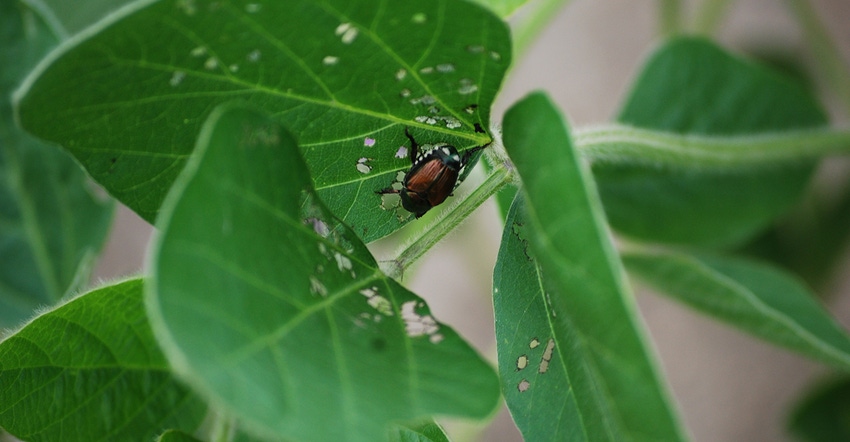
Predicting future pest problems is well outside of Kelly Estes’ comfort zone. As the University of Illinois agricultural pest survey coordinator, Estes presented her top four pest concerns for 2017 in February. So far, her forecast is spot-on.
“What a crazy year for insects,” she explains. “Japanese beetles are back. I’ve seen lots of Japanese beetle pictures and had reports from all over, as well. It seems like western Illinois may be taking the brunt of it, or that’s just where I happen to be getting the most reports.”
The mild winter gave the high 2016 populations a running start, she explains. There is a direct correlation between high 2016 counts, like in western Illinois, and significant pressure this season.
What should farmers do? Get out and scout, Estes says. Corn pollination is right around the corner, and farmers should consider insecticide treatments during silking if these three conditions are met:
• three or more beetles per ear
• silks clipped to less than half an inch
• pollination less than 50% complete
Don’t forget to factor in crop stages, Estes adds. Planting delays and replant situations have left corn and soybeans in various stages throughout the state. Crop stages impact Japanese beetle economic thresholds.
“Soybeans in the vegetative stage can withstand more defoliation,” Estes explains. “The percent defoliation decreases on the economic threshold when soybeans reach the reproductive stages.” Farmers should consider insecticide treatments when defoliation reaches 30% before bloom and 20% between bloom and pod fill, she notes.
Scout rows within fields and not just field edges, Estes notes. Higher populations lurk on field edges, and counts may be skewed.
Other pest concerns
Western corn rootworm, black cutworm and brown marmorated stinkbug rounded out Estes’ preseason predictions. Western corn rootworm reports began rolling in over the Independence Day weekend.
“Everyone is curious if populations are on the rebound,” she notes. Silking corn in dry soils throughout central Illinois could be a target for Western corn rootworm. “Really, only time will tell,” she adds.
Brown marmorated stinkbug remains high on her watch list as populations grow. Homes and gardens are the focus right now, but Estes anticipates that row and specialty crops will soon become hosts to the troublesome pest.

BROWN MARMORATED STINKBUG: “The world is their buffet at this point,” says Kelly Estes of brown marmorated stinkbugs. “While we may not see them causing injury in our corn and soybean fields yet, our specialty crops and even our backyard home gardens may be the first place to notice injury.”

In May, Estes tracked several significant black cutworm flights. “We saw heavy black cutworm flights across Illinois,” she notes. “Not only were numbers in traps high, but they were sustained flights. Several counties, like Champaign and Lee, saw repeated significant flights.”
A look ahead
Estes and her scouting crew haven’t had too much downtime this season. “There’s just been a steady flow of insect issues,” she says. “As we progressed into June, thistle caterpillar took center stage for about two weeks, and now it’s Japanese beetles.”
Alone, thistle caterpillars and Japanese beetles are not a significant threat. Problems occur when dealing with multiple defoliating pests at the same time. “Collectively, you have to look at defoliation and determine if it’s high enough to treat,” Estes says.
What’s with the influx of pests this season? It’s hard to pinpoint one cause, Estes explains, but the mild winter and difficult planting season, with several replanted acres, likely played a role. “Farmers weren’t getting into fields early and taking winter annuals out,” she notes. “That creates a nice reservoir for spring insects.”
Cultural practices such as no-till and cover cropping tend to favor slugs, stinkbugs and armyworms. There’s no end in sight as western bean cutworm, fall armyworm, corn borer and earworm traps are set and ready to track pressure across the state until September.
Harvest may be weeks away, but Estes is already prepared to field phone calls this fall.
“We always get calls close to harvest about ear feeding,” she says. “Unfortunately, without an insect present, it’s really hard to confirm the main culprit. The only way to really know is to get out and scout.”
About the Author(s)
You May Also Like




